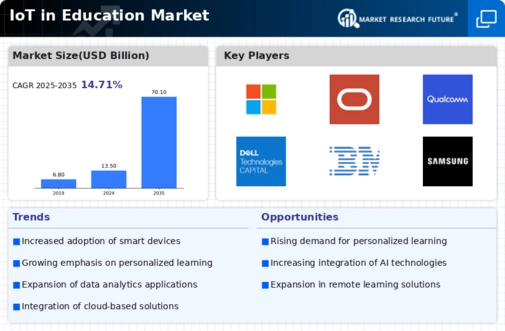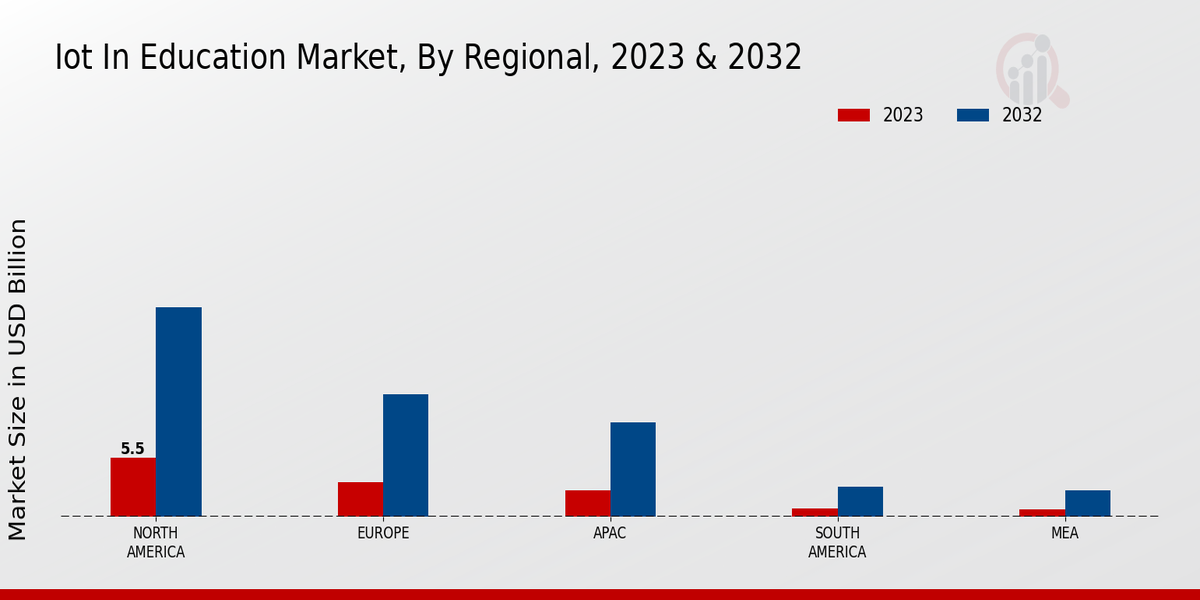Market Growth Projections
The Global IoT in Education Market Industry is poised for substantial growth, with projections indicating a rise from 13.5 USD Billion in 2024 to 70.1 USD Billion by 2035. This growth trajectory reflects a compound annual growth rate of 16.15% from 2025 to 2035, highlighting the increasing investment in IoT technologies within educational settings. As institutions continue to embrace digital transformation, the demand for innovative IoT solutions is expected to surge, driven by factors such as enhanced learning experiences, improved operational efficiencies, and the need for data-driven decision-making. The market's evolution will likely reshape the future of education on a global scale.
Government Initiatives and Funding
Government initiatives aimed at enhancing digital education infrastructure are pivotal in propelling the Global IoT in Education Market Industry. Various governments are investing in technology integration within schools, promoting the adoption of IoT solutions. For example, funding programs and grants are being established to support the implementation of smart classrooms and connected learning environments. These initiatives not only enhance educational access but also ensure that institutions can keep pace with technological advancements. As a result, the market is likely to experience robust growth, with a compound annual growth rate of 16.15% projected from 2025 to 2035.
Increased Adoption of Smart Devices
The proliferation of smart devices in educational settings is a primary driver of the Global IoT in Education Market Industry. Schools and universities are increasingly integrating tablets, smartboards, and IoT-enabled learning tools into their curricula. This trend is expected to contribute to the market's growth, projected to reach 13.5 USD Billion in 2024. The integration of these devices enhances interactive learning experiences, allowing educators to tailor lessons to individual student needs. As institutions recognize the benefits of personalized education, the demand for IoT solutions is likely to rise, fostering a more engaging and effective learning environment.
Enhanced Data Analytics Capabilities
The ability to collect and analyze data in real-time is transforming educational methodologies, thereby driving the Global IoT in Education Market Industry. IoT devices facilitate the gathering of vast amounts of data on student performance and engagement. This data can be leveraged to inform teaching strategies and improve learning outcomes. For instance, analytics tools can identify students who may require additional support, allowing educators to intervene proactively. As educational institutions increasingly rely on data-driven decision-making, the market is anticipated to grow significantly, with projections indicating a rise to 70.1 USD Billion by 2035.
Integration of Artificial Intelligence
The integration of artificial intelligence (AI) with IoT technologies is reshaping the educational landscape, thereby influencing the Global IoT in Education Market Industry. AI-powered tools can analyze student data to provide personalized learning experiences, adapting content to meet individual needs. This synergy between AI and IoT enhances the effectiveness of educational programs, making learning more engaging and efficient. As educational institutions recognize the potential of these technologies to improve student outcomes, the demand for AI-integrated IoT solutions is likely to increase. This trend is expected to contribute to the overall market growth, aligning with the projected figures for the coming years.
Growing Demand for Remote Learning Solutions
The demand for remote learning solutions is a significant factor influencing the Global IoT in Education Market Industry. As educational institutions adapt to diverse learning environments, IoT technologies facilitate seamless remote education experiences. Tools such as virtual classrooms and online collaboration platforms enable students to engage with their peers and instructors from anywhere. This shift towards hybrid learning models is expected to drive market growth, as institutions seek to implement IoT solutions that enhance connectivity and accessibility. The market's expansion reflects a broader trend towards flexible learning options, which are increasingly favored by students and educators alike.













